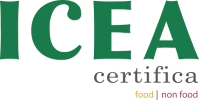EU Organic Farming (Regulation (EC) No. 834/07)
It certifies agricultural products, processed agri-food products, feed and pet food, aquaculture products, algae and microalgae (spirulina), yeasts. It guarantees the conformity of organic production at all stages of the production chain, from farm to table, in compliance with the EU regulations (Regulation (EC) No. 834/07 and (EC) No. 889/08)
What it is certified
Animal Husbandry
Organic livestock farming shall ensure a close functional link with the land and a number of animals proportioned to the production capacity of the farm; the number of livestock shall not exceed 2 Uba/Ha.
The attention to animal welfare is maximum, the density of livestock in the stable is sharply limited, and the space for walking (movement) is much larger than the minimums required by law. Only free housing or grazing are allowed.
Organic animals are fed on high-quality, non-GMO raw materials, which are derived from organic farming and, as far as possible, are of farm origin.
Weaning times are longer than those typically followed in intensive animal farming.
Veterinary interventions shall give priority to natural methods such as homoeopathy, phytotherapy, etc.
The use of conventional drugs is allowed, but only in case of extreme necessity, doubling the withdrawal time.
The presence of organic and conventional animal farming of the same species is not allowed in the same farm. The duration of the conversion period varies according to the species (e.g. six months for pigs and dairy cattle, twelve months for beef cattle, ten weeks for poultry).
In the case of simultaneous conversion of land and cattle farming, such period shall be fixed at 24 months.
In accordance with art. 42 (Regulation (EC) No. 834/07), following the approval of specific national specifications, particular species (aviculture, silkworm rearing, snail farming and algae spirulina) for which technical standards have not yet been defined at European Community level, may also be certified under Regulation (EC) No. 834/07.
Beekeeping
Organic beekeeping pays particular attention to the quality of the environment and defence techniques. The location of apiaries is a crucial choice; priority should be given to land organically managed or with low-environmental cultivation techniques. In any case, sufficient distances from motorways, urban centres, industrial areas, etc. shall be guaranteed.
With respect to the protection against diseases, beekeepers must first of all put in place appropriate preventive measures, such as choice of rustic breeds, periodic renewal of queens and waxes, constant monitoring of broods, etc., to prevent the spread of diseases.
In the case of disease (varroasis is the most feared) the use of synthetic acaricides is not allowed, but only the use natural products registered as veterinary medicines for beekeeping such as: formic acids, oxalic acid and essential oils such as thymol.
The conversion period lasts at least one year, during which the honeycomb wax must be replaced by organic wax for at least 50% or, in any case, according to the strictly binding analytical parameters defined by control bodies.
How to certify
The certification process is divided into five main phases:
- Notification of production activities to the competent authority through the Biological Information System (SIB) or similar regional systems. The operator shall declare the type of activities, production units and activity chains subject to control. Farms shall declare all agricultural lands exploited in organic farming systems and converted or conventionally managed. In the case of livestock production, the type and size of livestock farming are also declared.
- Initial assessment of the production process, the operator shall submit a management plan in order to describe all the measures he intends to take to comply with the organic requirements relating to the activity carried out. In the case of livestock production, the operator shall submit the farm management plan and the management plan for livestock manure. Based on the activities carried out, the operator presents Plant Production Plan (PAPV), Preparations Plan (PAP) and Animal Husbandry/Beekeeping Plan (PAPZ), which must be annually updated according to the procedures and deadlines established. Beekeepers will have to declare all sites where apiaries will be located.
- Start-up inspection to verify the correct application and effectiveness of declared management plan measures and other related documents. In addition, the suitability of the structures and the correct management of the company’s production processes are assessed as required by the European regulations for the different fields of activity.
- Issue of Documentary Evidence and Certificate of Conformity based on the information and data collected as part of the assessment and verification process. The Certificate of Conformity lists the certified products. In the case of livestock and beekeeping, there is no provision for products to be marketed under the indication “in conversion to organic farming”.
- Annual surveillance through periodic inspections and planned analyses based on a careful risk analysis, aimed at confirming the maintenance of compliance conditions and the punctual and accurate keeping of the obligatory records required for control purposes.
Documents and downloadable files
[button color=”green” size=”normal” alignment=”none” rel=”follow” openin=”newwindow” url=”https://www.icea.bio/wp-content/uploads/2017/01/2.-M0202-Regolamento-Tecnico-834-Ed03-Rev00-Certificazione-Biologica-EU-Europa-ICEA-Istituto-di-Certificazione-Etica-e-Ambientale.pdf”]Regulation for certification[/button]
[button color=”green” size=”normal” alignment=”none” rel=”follow” openin=”newwindow” url=”https://www.icea.bio/wp-content/uploads/2017/01/3.-M0201-Contratto-certificazione-834-Ed02-Rev04-Certificazione-Biologica-EU-Europa-ICEA-Istituto-di-Certificazione-Etica-e-Ambientale.pdf”]Contract for certifcation[/button]
[button color=”green” size=”normal” alignment=”none” rel=”follow” openin=”newwindow” url=”https://www.icea.bio/wp-content/uploads/2017/01/4.-M0320-Piano-Utilizzo-Deiezioni-Ed03-Rev00-Certificazione-Biologica-EU-Europa-Zootecnia-ICEA-Istituto-di-Certificazione-Etica-e-Ambientale.xls”]Plan for the use of livestock manure[/button]
[button color=”green” size=”normal” alignment=”none” rel=”follow” openin=”newwindow” url=”https://www.icea.bio/wp-content/uploads/2017/01/5-Modulo-apicoltura-3B.6-Certificazione-Biologica-EU-ICEA-Istituto-di-Certificazione-Etica-e-Ambientale.doc”]Beekeeping[/button]
[button color=”green” size=”normal” alignment=”none” rel=”follow” openin=”newwindow” url=”https://www.icea.bio/wp-content/uploads/2017/01/5.-M0321-PGA-Ed02-Certificazione-Biologica-EU-Europa-Zootecnia-ICEA-Istituto-di-Certificazione-Etica-e-Ambientale.xls”]Livestock management plan[/button]
[button color=”green” size=”normal” alignment=”none” rel=”follow” openin=”newwindow” url=”https://www.icea.bio/wp-content/uploads/2017/01/6.-M0322-PAP-ZOO-Ed02-Certificazione-Biologica-EU-Europa-Zootecnia-ICEA-Istituto-di-Certificazione-Etica-e-Ambientale.xls”]PAP ZOO[/button]
Contact ICEA
ICEA Piemonte, Liguria and Valle D’Aosta

